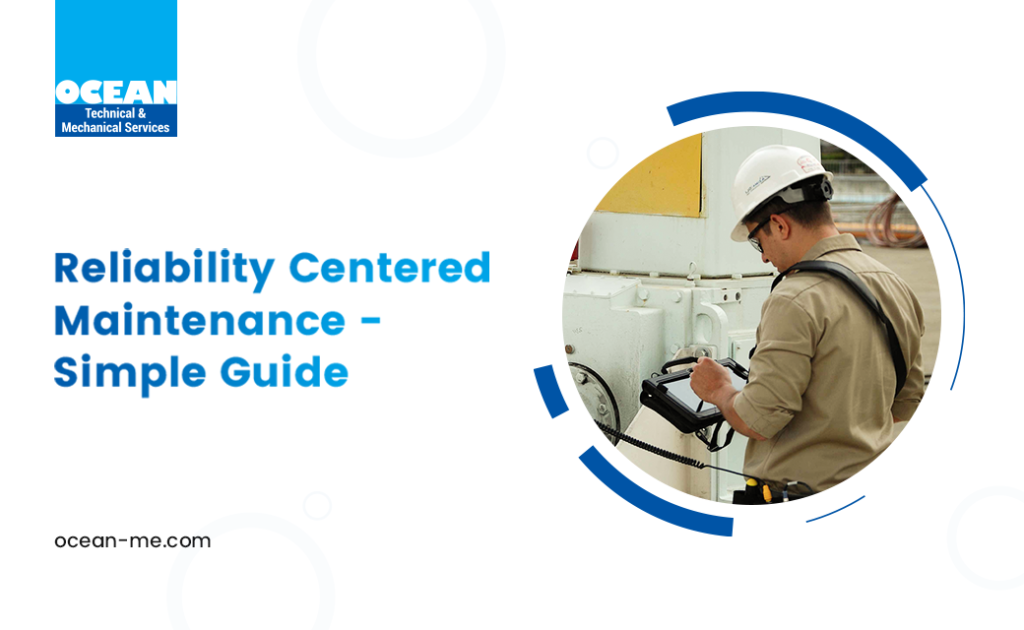The goal of reliability centered maintenance is to identify the best possible maintenance plan for the assets in your business to maximise their availability and dependability. When it comes to maintenance management, it is not advisable to apply a one-size-fits-all approach since different assets have varied needs, capabilities, and functionalities — as well as diverse failure modes. This implies that the causes of their failures, the effects they have, and the methods used to avoid them are all different. In a word, reliability centered maintenance is all about figuring out what works and making it function as efficiently as possible for you.
As we previously stated, different assets require different maintenance management strategies. For instance, some assets may require continuous high-tech monitoring, an area in which Ocean Technical and Mechanical Services excels, while others may be simply left until they fail, also known as run-to-failure; for the majority of assets, preventive maintenance is the best option.
Read more about:
- Common causes of Piping Vibration and their effects on piping systems
- Ultrasonic flow measurement services
- The Importance of Vibration Analysis in Maintenance
How Should You Choose the Most Effective Maintenance Plan?
You should start by reviewing the history of previous asset failures and the actions you took to maintain and repair them. You may choose the best asset maintenance approach by looking at what has worked the best in the past. Reliability centered maintenance’s major objective is to gain the maximum return on investment (ROI) while maintaining high-reliability levels.
The Principles Behind Reliability Centered Maintenance
According to the RCM paradigm, it is desirable to conduct less maintenance on an asset. Maintenance should only be carried out when it is essential or when the advantages exceed the risks and expenses. RCM is focused on four main goals:
- Maintain system operations
- Determine the failure modes that might impact system operations
- Determine which failure modes to prioritise based on risk and cost estimates
- Choose the tasks that will control failure modes best
What Industries Use Reliability Centered Maintenance?
The technique of reliability centered maintenance was first used in the aviation sector, where it is still widely used today. It has now spread to other sectors, including:
- Fabrication of military hardware
- Nuclear energy
- Manufacturing steel
- Aviation
- Sanitisation in food products
- Production of pharmaceuticals
Where there are significant repercussions for failure, RCM is always implemented. A flaw in pharmaceutical medicine, for instance, might hurt, ill-effect, or even kill thousands of individuals who use it. Pharmaceutical companies use an RCM approach for this reason.
Benefits and Drawbacks of Reliability Centred Maintenance
Organizations with financial resources benefit from successfully implementing RCM. The approach helps businesses maintain assets consistently, systematically, and economically by taking the guessing out of maintenance prioritisation.
RCM’s benefits and drawbacks are similar to those of predictive maintenance (PdM), which it mainly relies on. By using RCM instead of a single PDM method, facilities can better match resources to equipment needs, improve equipment reliability, and cut costs.
Benefits
Reliability centered maintenance has the following benefits:
- Cost efficiency. By reducing needless routine maintenance work, RCM aids in cost reduction. When used in conjunction with preventive maintenance, RCM has been shown to cut work by 70%
- Improved teamwork RCM approaches maintenance duties collectively. When everyone participates in the issue analysis and decision-making process, communication and cooperation between departments and teams increase
- Enhancing asset performance. Additionally, it gets rid of pointless overhauls, which cuts down on shutdowns. Rapid failure diagnosis is another benefit of RCM
- Enhanced worker motivation. Employees have a better grasp of the assets in their operational setting when they participate in the use of RCM. This encourages them to take charge of maintenance issues and fixes
- Improved environmental integrity and safety. Every failure mode has repercussions, and RCM tries to understand them to take preventive action. The maintenance priority procedure makes sure that safety equipment is available and also reduces breakdowns
You may also like to read:
Drawbacks
RCM has disadvantages as well. RCM implementation comes with significant upfront expenditures. Teams must commit a substantial amount of time, money, and resources to begin doing RCM analysis.
RCM concurrently integrates all other types of maintenance procedures, including some of their shortcomings, which is its second big issue. Say, for example, that you decide to use a run-to-failure strategy for a certain asset. You also face the chance of experiencing an unexpected failure. Because of this, RCM is occasionally considered to be more expensive than operating standalone predictive or preventive maintenance programmes.
The majority of experts concur that RCM is more cost-effective in the long run, nonetheless.
Reach Your Goals with RCM
Reliability centered maintenance identifies the company’s most crucial operations, strives to improve maintenance tactics to reduce system failures, and eventually raises equipment availability and dependability. The most important assets are those with high failure rates or serious repercussions. This maintenance approach identifies potential failure mechanisms and their effects while taking into account how the equipment will operate. As a result, it is possible to decide on cost-effective maintenance strategies that reduce the likelihood of failure. Thus, the facility’s overall dependability is then increased by implementing the most efficient approaches.



